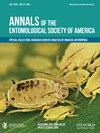玻璃翼尖刺蝉的交配信号和一夫多妻现象(半翅目:蝉科)
IF 3
3区 农林科学
Q1 ENTOMOLOGY
引用次数: 1
摘要
摘要寻找伴侣可能只是确保后代成功交配的一部分。雌性在交配期间或交配后经常表现出隐蔽的雌性选择(CFC),这可能会影响其多个伴侣的精子被选择用于卵子受精。已知的CFC行为机制包括通过男性的结婚礼物、交配持续时间和精液含量来评估男性。在本研究中,研究了玻璃翼神枪手Homalodissa tropicpennis(Germar)(半翅目:蝉科)在交配过程中的行为。玻璃翼神枪手(GWSS)在交配发生前使用振动通信。然而,人们对交配期间和交配后发生的行为知之甚少。这项研究的结果表明,交配过程中也会发生振动信号。在交配过程中,人们发现了与交配前通信过程中发出的振动信号相似的振动信号,同时还发现了一种新的“类似嗡嗡声”的信号,这种信号通常发生在交配后10秒内。此外,结果确定交配持续时间平均为15小时,尽管在观察到的雄性-雌性配对中,交配持续时间为10小时(8.5–18.5小时)。最后,雄性和雌性交配不止一次。总之,研究结果确定了GWSS中发生CFC所需的关键繁殖参数。该研究扩展了使用CFC的已知动物,并强调了交配振动通信可能发挥的作用,为未来更深入的研究奠定了基础。从生态学角度和害虫防治方法的发展来看,了解成功生产后代所需的昆虫行为是重要的。本文章由计算机程序翻译,如有差异,请以英文原文为准。
Copulatory Signaling and Polygamy of Glassy-Winged Sharpshooters (Hemiptera: Cicadellidae)
Abstract Finding a partner to mate with may be only part of ensuring successful siring of offspring. Females often exhibit cryptic female choice (CFC) during or after copulation, which can influence whose sperm from her multiple partners is chosen for egg fertilization. Known behavioral mechanisms for CFC include assessment of males by their nuptial gifts, duration of copulation, and seminal fluid contents. In this study, the glassy-winged sharpshooter, Homalodisca vitripennis (Germar) (Hemiptera: Cicadellidae), behaviors during the course of copulation were investigated. Glassy-winged sharpshooter (GWSS) use vibrational communication before copulation occurs. However, little is known about behaviors that occur during and after copulation. Results from this study determined that vibrational signaling also occurs during copulation. Vibrational signals similar to those emitted during precopulatory communication were identified during copulation alongside a new, ‘hum-like’ signal that typically occurred within 10 s after the pair joined in copulation. In addition, results determined the duration of copulation was on average of 15 h, though with a 10-h range (8.5–18.5 h) among observed male–female pairs. Finally, both males and females mated more than once. Collectively, results identified key reproductive parameters required for CFC to occur in GWSS.The study expands on the known animals that use CFC and emphasizes the role that copulatory vibrational communication may play setting the foundations for future more in-depth studies. Understanding of insect behaviors necessary for successful production of offspring is important from an ecological perspective and for development of pest control methods.
求助全文
通过发布文献求助,成功后即可免费获取论文全文。
去求助
来源期刊
CiteScore
4.90
自引率
0.00%
发文量
25
审稿时长
6-12 weeks
期刊介绍:
The Annals of the Entomological Society of America exists to stimulate interdisciplinary dialogue across the entomological disciplines and to advance cooperative interaction among diverse groups of entomologists. It seeks to attract and publish cutting-edge research, reviews, collections of articles on a common topic of broad interest, and discussion of topics with national or international importance. We especially welcome articles covering developing areas of research, controversial issues or debate, and topics of importance to society. Manuscripts that are primarily reports of new species, methodology, pest management, or the biology of single species generally will be referred to other journals of the ESA. The most important criteria for acceptance are quality of work and breadth of interest to the readership.

 求助内容:
求助内容: 应助结果提醒方式:
应助结果提醒方式:


